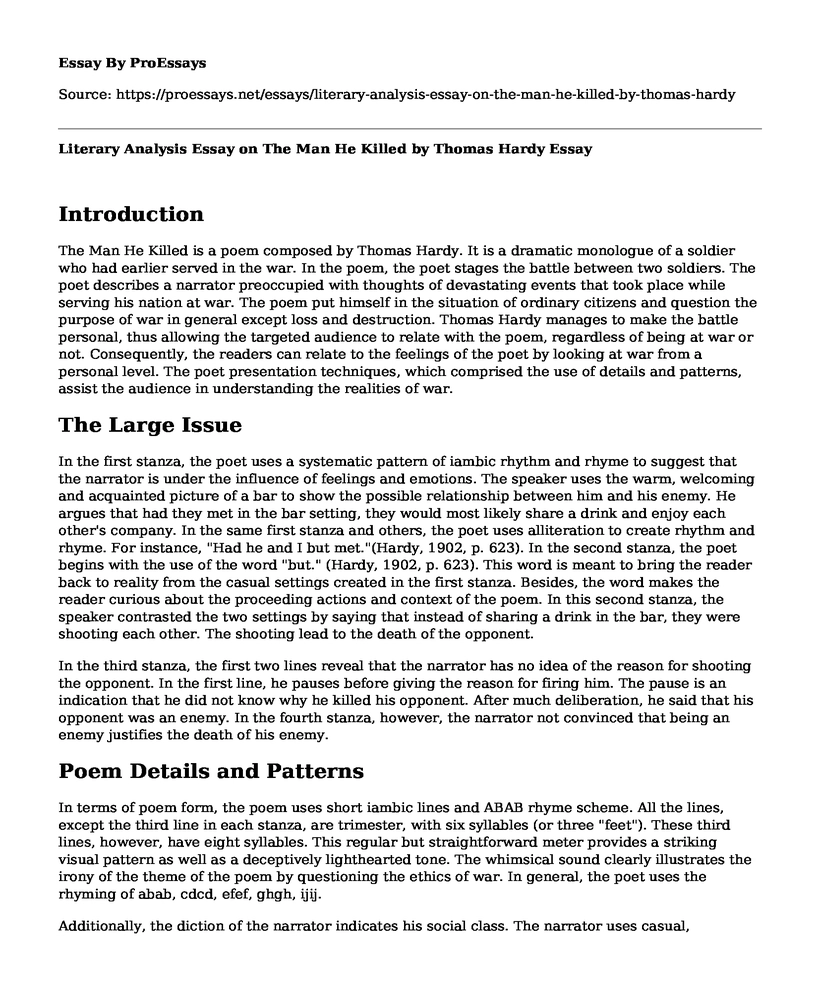Introduction
The Man He Killed is a poem composed by Thomas Hardy. It is a dramatic monologue of a soldier who had earlier served in the war. In the poem, the poet stages the battle between two soldiers. The poet describes a narrator preoccupied with thoughts of devastating events that took place while serving his nation at war. The poem put himself in the situation of ordinary citizens and question the purpose of war in general except loss and destruction. Thomas Hardy manages to make the battle personal, thus allowing the targeted audience to relate with the poem, regardless of being at war or not. Consequently, the readers can relate to the feelings of the poet by looking at war from a personal level. The poet presentation techniques, which comprised the use of details and patterns, assist the audience in understanding the realities of war.
The Large Issue
In the first stanza, the poet uses a systematic pattern of iambic rhythm and rhyme to suggest that the narrator is under the influence of feelings and emotions. The speaker uses the warm, welcoming and acquainted picture of a bar to show the possible relationship between him and his enemy. He argues that had they met in the bar setting, they would most likely share a drink and enjoy each other's company. In the same first stanza and others, the poet uses alliteration to create rhythm and rhyme. For instance, "Had he and I but met."(Hardy, 1902, p. 623). In the second stanza, the poet begins with the use of the word "but." (Hardy, 1902, p. 623). This word is meant to bring the reader back to reality from the casual settings created in the first stanza. Besides, the word makes the reader curious about the proceeding actions and context of the poem. In this second stanza, the speaker contrasted the two settings by saying that instead of sharing a drink in the bar, they were shooting each other. The shooting lead to the death of the opponent.
In the third stanza, the first two lines reveal that the narrator has no idea of the reason for shooting the opponent. In the first line, he pauses before giving the reason for firing him. The pause is an indication that he did not know why he killed his opponent. After much deliberation, he said that his opponent was an enemy. In the fourth stanza, however, the narrator not convinced that being an enemy justifies the death of his enemy.
Poem Details and Patterns
In terms of poem form, the poem uses short iambic lines and ABAB rhyme scheme. All the lines, except the third line in each stanza, are trimester, with six syllables (or three "feet"). These third lines, however, have eight syllables. This regular but straightforward meter provides a striking visual pattern as well as a deceptively lighthearted tone. The whimsical sound clearly illustrates the irony of the theme of the poem by questioning the ethics of war. In general, the poet uses the rhyming of abab, cdcd, efef, ghgh, ijij.
Additionally, the diction of the narrator indicates his social class. The narrator uses casual, colloquial vocabulary intermixed with slang words such as list for enlist, and nipperkin, for a small drink. This diction shows that the speaker belongs to a lower-class social status.
The careful use of details and patterns in the poem, help the poet to present the issue of the ethics of war effectively. The diction used to indicate the social status of the narrator, the pause and hesitation show that even shoulders do not know the reason why they kill each other at war. The meter, form, and rhyme in the poem help create a striking visual pattern, while alliteration help creates rhythm and rhyme in the poem. These patterns and details help the poet to present the theme of the poem successfully.
References
Poetry Foundation. (2017, January 2). The Man He Killed by Thomas Hardy. Retrieved from https://www.poetryfoundation.org/poems/44329/the-man-he-killed
Cite this page
Literary Analysis Essay on The Man He Killed by Thomas Hardy. (2023, Feb 13). Retrieved from https://proessays.net/essays/literary-analysis-essay-on-the-man-he-killed-by-thomas-hardy
If you are the original author of this essay and no longer wish to have it published on the ProEssays website, please click below to request its removal:
- American Noirs Comparative Essay
- Power Struggle in Macbeth Essay
- Paper Example on Racism in William Shakespeare's Othello
- Gorge Orwell's 1984 and Language Essay
- Literary Analysis Essay on "After Hegemony"
- Paper Example on Hope's Feather: Emily Dickinson's Poem
- Established Genres: A Reflection of Life Experiences - Essay Example







